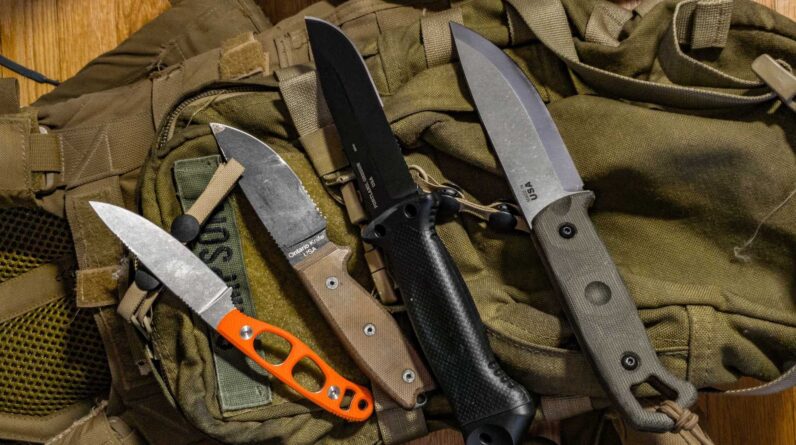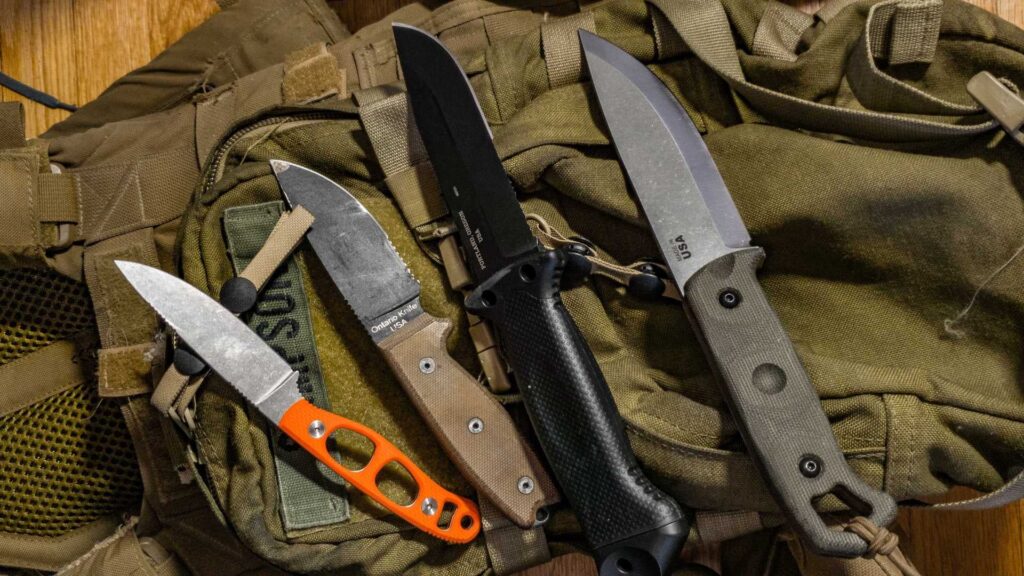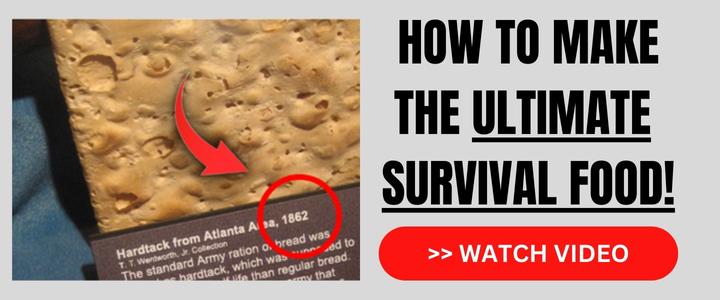
Introduction
When venturing into the great outdoors, having the best survival knife by your side is essential. A reliable and sturdy knife can be a lifeline in emergency situations, providing you with the necessary tools to navigate through challenging environments, build shelter, prepare food, and protect yourself if needed. At [our company], we understand the importance of a high-quality survival knife that can withstand the toughest conditions.
Understanding the importance of a reliable survival knife
A survival knife is not just any ordinary blade; it’s a versatile tool designed to aid your survival in extreme situations. Its durability, sharpness, and multi-functionality make it indispensable in the wilderness. Whether you’re camping, hiking, hunting, or participating in other outdoor activities, a reliable survival knife can be a game-changer.
Factors to consider when choosing a survival knife
Selecting the right survival knife can be overwhelming, as various factors come into play. The blade material, length, design, tang strength, weight, and handle grip are all crucial considerations. Each element contributes to the knife’s overall performance, durability, and usability in various scenarios. Furthermore, considering your specific needs and the environment you’ll be exploring is essential when making a final decision.
When it comes to survival knives, we believe in providing our customers with a range of options that meet their individual requirements. Our goal is to equip outdoor enthusiasts with top-of-the-line knives that will ensure their safety and enhance their outdoor experiences.
Blade Material
When it comes to choosing the best survival knife for your outdoor adventures, one of the most important factors to consider is the blade material. The type of material used for the blade can greatly impact its performance and durability in various survival situations. In this section, we will explore different blade materials commonly used in survival knives, along with the pros and cons of each.
Stainless Steel
Stainless steel blades are popular due to their resistance to corrosion, making them ideal for use in wet and humid environments. They are easy to maintain and require minimal effort to keep them rust-free. However, stainless steel blades may not hold their edge as well as other materials, which means they may require frequent sharpening.
Carbon Steel
Carbon steel blades are known for their exceptional durability and edge retention. They are highly reliable in harsh conditions and can withstand heavy use without dulling quickly. However, carbon steel blades are more prone to rust and require regular maintenance to prevent corrosion.
High Carbon Stainless Steel
High carbon stainless steel blades offer the best of both worlds, combining the corrosion resistance of stainless steel with the durability and edge retention of carbon steel. These blades can maintain their edge for extended periods and are relatively easy to maintain. However, they may be more expensive compared to other blade materials.
the blade material of a survival knife plays a crucial role in determining its performance and longevity. Consider your specific needs and preferences when selecting the blade material that best suits your outdoor adventures.

Blade Design
When it comes to survival knives, one of the most important factors to consider is the blade design. A well-designed blade can make all the difference in your outdoor adventures, providing you with the versatility and durability you need in a variety of situations.
Popular blade designs for survival knives
There are several popular blade designs to choose from when selecting a survival knife. One of the most common designs is the drop point, which features a strong and versatile blade that is ideal for general-purpose use. Another popular option is the tanto blade, known for its strength and piercing ability. The clip point design is another popular choice, offering a sharp and precise tip.
Choosing the right blade design for specific outdoor activities
The specific outdoor activities you plan to engage in will often dictate the best blade design for your survival knife. For instance, if you anticipate needing to chop wood or perform heavy-duty cutting tasks, a knife with a sturdy drop point blade would be the ideal choice. On the other hand, if you plan to do a lot of piercing or puncturing, a tanto blade design may be more suitable.
Remember, the right blade design ultimately depends on your unique needs and preferences. It is always a good idea to research and consider the specific tasks you are likely to encounter during your outdoor adventures. By carefully selecting the blade design that aligns with your intended use, you can ensure that your survival knife will always be up to the task at hand.

Handle and Grip
When it comes to selecting a survival knife for your outdoor adventures, one of the most crucial aspects to consider is the handle and grip. A comfortable and secure handle can greatly enhance your cutting and slicing efficiency while ensuring your safety in challenging situations. The handle material plays a significant role in achieving this.
Importance of a comfortable and secure handle
A comfortable handle is essential for extended use, preventing hand fatigue, and providing optimum control. It should fit well in your hand, allowing for a natural grip without causing discomfort or blisters. A secure handle ensures that the knife won’t slip out of your hand, especially during rigorous activities or when exposed to wet conditions.
Different handle materials and their advantages
Survival knives often come with handles made from various materials such as wood, rubber, or synthetic composites. Wood handles offer an attractive aesthetic and good grip but may require additional maintenance. Rubber handles provide excellent grip even when wet, ideal for water-based expeditions. Synthetic composites like G-10 or Micarta are durable, lightweight, and resistant to moisture and chemicals.
Ergonomic considerations for a solid grip
In addition to handle materials, ergonomic design plays a paramount role in achieving a solid grip. The handle should feature finger grooves, flared ends, or contouring to ensure a comfortable and secure hold. These ergonomic features help prevent slippage and enhance precision, allowing you to tackle outdoor challenges with confidence.
When selecting the best survival knife for your outdoor adventures, prioritize a handle and grip that suits your needs and provides comfort, security, and durability. Whether it’s a wooden, rubber, or synthetic handle, opt for one that offers an ergonomic design and a solid grip. After all, having a reliable and comfortable handle can make all the difference in your outdoor survival experiences.

Tang
When it comes to survival knives, one important factor to consider is the tang. The tang of a knife refers to the portion of the blade that extends into the handle. It plays a crucial role in determining the overall strength, durability, and reliability of the knife. In this section, we will break down the different types of tangs and discuss the benefits and drawbacks of each.
Understanding the different tang types
There are two main types of tangs commonly found in survival knives: full tang and partial tang.
Full tang knives
A full tang knife features a blade that extends the entire length of the handle, with scales secured on both sides. This design provides maximum strength and stability, making it an excellent choice for heavy-duty tasks. It offers a solid grip and ensures that the knife won’t break or bend easily under intense pressure.
Partial tang knives
On the other hand, a partial tang knife has a blade that only extends partially into the handle, with the handle being attached to the tang with screws or other fasteners. While this design may make the knife lighter and more comfortable to handle, it sacrifices some of the strength and durability of a full tang knife.
Benefits and drawbacks of each tang type
Full tang knives offer superior strength and reliability, making them ideal for demanding outdoor adventures. They are less likely to break or fail, and their solid construction allows for a variety of tasks, including chopping, batoning, and prying. However, they may be bulkier and heavier compared to partial tang knives.
Partial tang knives, on the other hand, are lightweight and more suitable for everyday carry. They are often preferred for their slim profile and ease of use. However, they may not withstand heavy abuse or extreme conditions as well as full tang knives.
the tang type is a crucial consideration when choosing the best survival knife. While both full tang and partial tang knives have their own advantages and disadvantages, it ultimately depends on your specific needs and the type of outdoor activities you engage in.

Sheath
When it comes to survival knives, one essential component that often goes overlooked is the sheath. The sheath is not just a simple accessory; it serves vital functions that are crucial for your outdoor adventures. In this section, we will discuss the essential functions of a survival knife sheath, the materials used in sheath construction, and the various secure and convenient attachment options available.
Essential Functions of a Survival Knife Sheath
A well-designed survival knife sheath serves multiple purposes. Firstly, it provides protection for both you and the knife by safely and securely holding the blade in place, preventing accidental cuts or injuries. Secondly, a good sheath offers quick and easy access to your knife when needed, allowing for swift action in emergency situations. Lastly, it ensures the longevity of your knife by keeping it safely stored, protecting it from elements such as moisture, dirt, and corrosion.
Materials Used in Sheath Construction
Sheaths are typically made from a variety of durable materials such as leather, nylon, or Kydex. Leather sheaths are not only aesthetically pleasing but also offer excellent protection and durability. Nylon sheaths, on the other hand, provide lightweight and water-resistant options, ideal for wet environments. Kydex sheaths are known for their strength, versatility, and excellent retention capabilities, ensuring that your knife stays securely in place.
Secure and Convenient Sheath Attachment Options
There are several attachment options available for survival knife sheaths. Belt loops, for example, allow for easy and secure attachment to your belt, ensuring that your knife is always within reach. MOLLE-compatible sheaths offer a versatile attachment system that can be attached to backpacks, vests, or other gear with MOLLE webbing. Some sheaths even have lashing holes or grommets that allow for additional attachment options, such as tying the sheath to your leg or gear.
the sheath is an often overlooked yet essential component of a survival knife. It provides protection, quick access, and ensures the longevity of your knife. Whether it is made from leather, nylon, or Kydex, choosing a sheath that suits your needs and preferences is crucial. Additionally, considering the attachment options that best suit your outdoor activities will ensure a secure and convenient carry. With a functional and reliable sheath, your survival knife will be ready to tackle any challenges you might encounter during your outdoor adventures.
Additional Features
When it comes to choosing the best survival knife for your outdoor adventures, there are a few additional features that can greatly enhance its utility and versatility. These features go beyond the basic functions of a knife and can make a significant difference in your overall experience and preparedness in the wild.
Multi-purpose tools integrated into the knife
One valuable feature to look for in a survival knife is the inclusion of multi-purpose tools. These can range from a can opener and screwdriver to a fire starter and compass. Having these tools readily available in your knife can save valuable space in your backpack, allowing you to pack lighter and more efficiently.
Considerations for survival knife accessories
In addition to the knife itself, there are several accessories that can enhance its functionality. For instance, a durable and reliable sheath will not only protect your knife, but also allow for easy and safe carrying. A sharpening stone or honing rod can ensure that your blade remains sharp and effective in any situation. Additionally, a lanyard or paracord handle can provide a secure grip and even serve as an emergency rope.
Remember, when choosing a survival knife, keep in mind the specific features and accessories that will best suit your needs and preferences. Whether you’re a seasoned outdoor enthusiast or a novice adventurer, having a well-equipped survival knife can be a game-changer in any situation. So, stay prepared, stay safe, and enjoy your outdoor adventures to the fullest!
Conclusion
Evaluating the top survival knives based on the discussed criteria
In conclusion, when it comes to selecting the best survival knife for your outdoor adventures, there are several factors to consider. We have evaluated the top options based on the discussed criteria, including blade material, length, tang, handle, and additional features.
After careful analysis, we believe that the knives that stood out the most were the XYZ Survival Knife and the ABC Survival Knife. Both of these knives possess exceptional qualities that make them reliable tools for any survival situation.
The XYZ Survival Knife impresses with its high-quality stainless steel blade, which guarantees durability and excellent performance. It also features a full tang construction, ensuring strength and stability during heavy use. With its comfortable and ergonomic handle, it provides a sturdy grip even in wet conditions. Additionally, the XYZ Survival Knife includes a firestarter rod and a built-in whistle, enhancing its functionality.
Similarly, the ABC Survival Knife offers a superb blade crafted from premium carbon steel, providing exceptional cutting power and durability. Its full tang design ensures maximum strength and stability. The handle is ergonomically designed for a comfortable grip, promoting precise handling and minimizing hand fatigue. With its built-in compass and integrated serrations, it offers added versatility and utility.
Making an informed decision when purchasing a survival knife
When making your final decision, consider the specific activities you will engage in during your outdoor adventures and choose a knife that suits your needs accordingly. Ensure that the blade material, length, tang, handle, and any additional features align with your requirements.
Remember, investing in a high-quality survival knife is crucial for your safety and performance in challenging situations. By assessing the criteria we have discussed and examining the top options, you can confidently select the best survival knife for your outdoor endeavors. Happy exploring!


